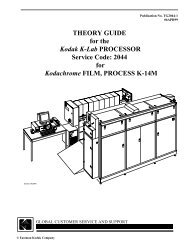KODAK T-MAX Professional Films - 125px
KODAK T-MAX Professional Films - 125px
KODAK T-MAX Professional Films - 125px
Create successful ePaper yourself
Turn your PDF publications into a flip-book with our unique Google optimized e-Paper software.
Adjustments for Long and Short Exposures<br />
At the exposure times in the table below, compensate for the<br />
reciprocity characteristics of this film by increasing the<br />
exposure as shown.<br />
If Indicated<br />
Exposure<br />
Time Is<br />
(seconds)<br />
Adjustments for Long and Short Exposures<br />
Use This<br />
Lens-<br />
Aperture<br />
Adjustment<br />
OR This<br />
Adjusted<br />
Exposure<br />
Time<br />
(seconds)<br />
1/10,000 None None<br />
1/1000 None None<br />
1/100 None None<br />
1/10 None None<br />
1 + 1 ⁄3 stop<br />
Change<br />
Aperture<br />
10 + 2 ⁄3 stop 15<br />
100 +2 stops 400<br />
Filter Corrections<br />
Increase exposure by the filter factor or the number of stops<br />
indicated when you use filters. For greatest exposure<br />
accuracy with a through-the-lens meter, take the meter<br />
reading without the filter over the lens, and then increase<br />
your exposure as shown in the table.<br />
<strong>KODAK</strong> WRATTEN<br />
Gelatin Filter<br />
Increase<br />
Lens Aperture<br />
By (f-stops)<br />
PROCESSING<br />
Handle unprocessed film in total darkness. Do not develop<br />
this film by inspection.<br />
With properly exposed film, the starting-point<br />
development times in the tables should produce negative<br />
contrast suitable for printing with a diffusion enlarger. For<br />
printing with a condenser enlarger, you may want to reduce<br />
the development time to produce a lower contrast; as a<br />
starting point, you can use the development time for the<br />
exposure index one stop lower than the exposure index<br />
you used to expose the film (see the processing tables). For<br />
example, if you exposed your film at EI 3200 and will print<br />
the negatives with a condenser enlarger, use the<br />
development time given for EI 1600.<br />
Filter Corrections<br />
Daylight Tungsten<br />
OR<br />
Increase<br />
Exposure By<br />
(filter factor)<br />
Increase<br />
Lens Aperture<br />
By (f-stops)<br />
<strong>KODAK</strong> T-<strong>MAX</strong> <strong>Professional</strong> <strong>Films</strong> • F-32 18<br />
OR<br />
Increase<br />
Exposure By<br />
(filter factor)<br />
No. 8 (yellow) 2<br />
⁄3 1.5 1<br />
⁄3 1.2<br />
No. 11 (yellowish green) 1 2 ⁄3 3 1 2 ⁄3 3<br />
No. 12 (deep yellow) 2<br />
⁄3 1.5 1<br />
⁄3 1.2<br />
No. 15 (deep yellow) 2<br />
⁄3 1.5 2<br />
⁄3 1.5<br />
No. 25 (red) 2 2 ⁄3 6 2 4<br />
No. 47 (blue) 3 1 ⁄3 9.5 4 1 ⁄3 19<br />
No. 58 (green) 2 2 ⁄3 6 2 2 ⁄3 6<br />
Polarizing Filter 1 1 ⁄3 2.5 1 1 ⁄3 2.5
















